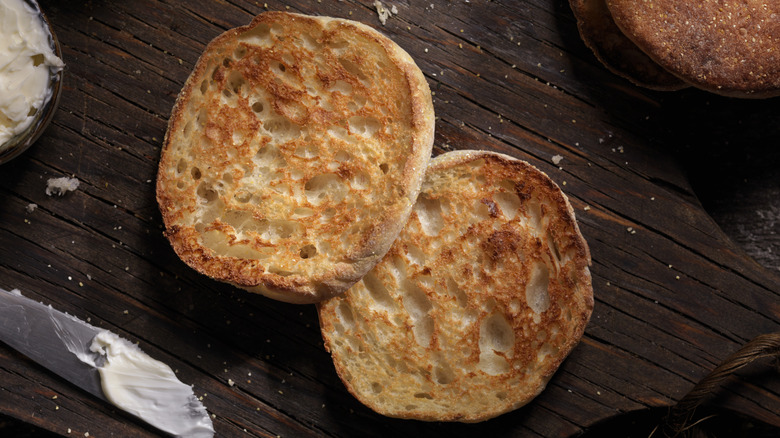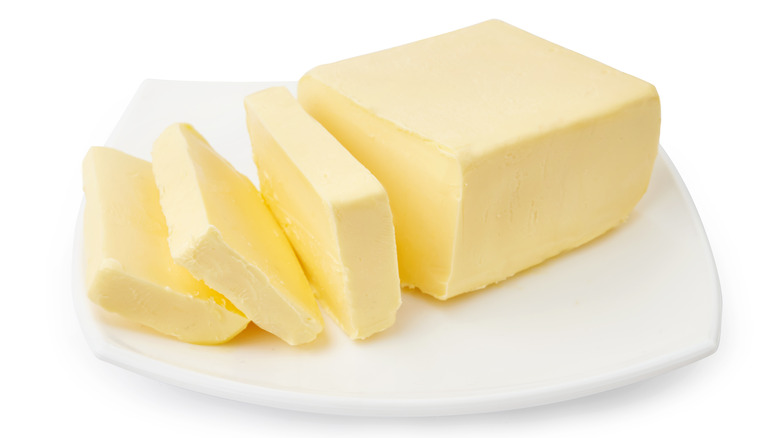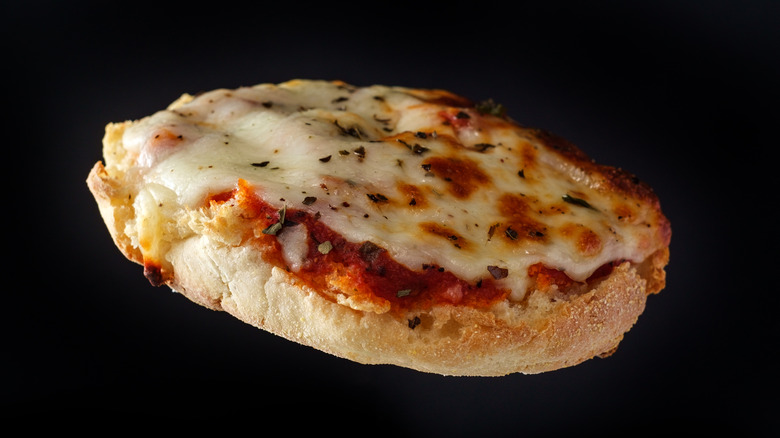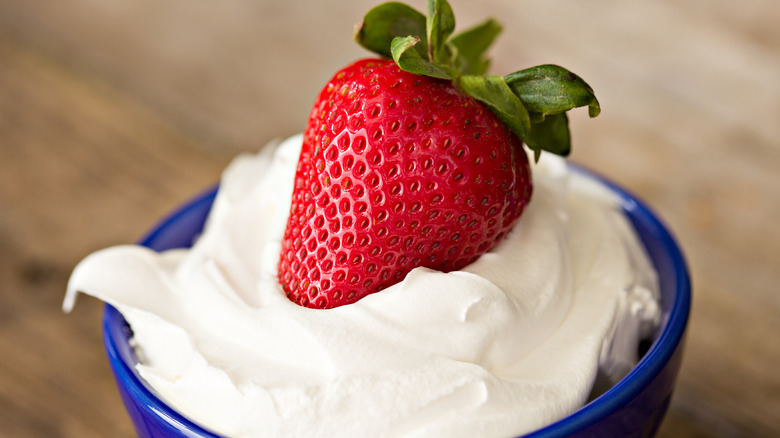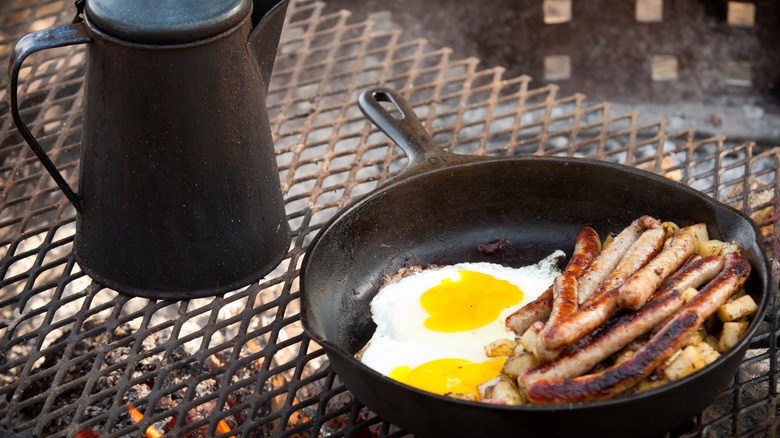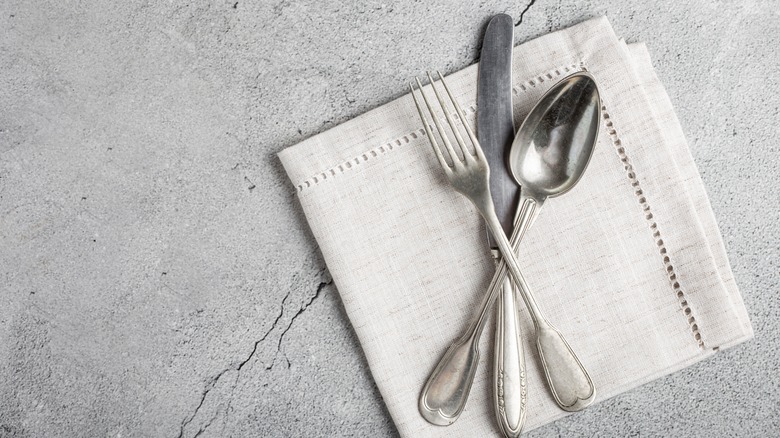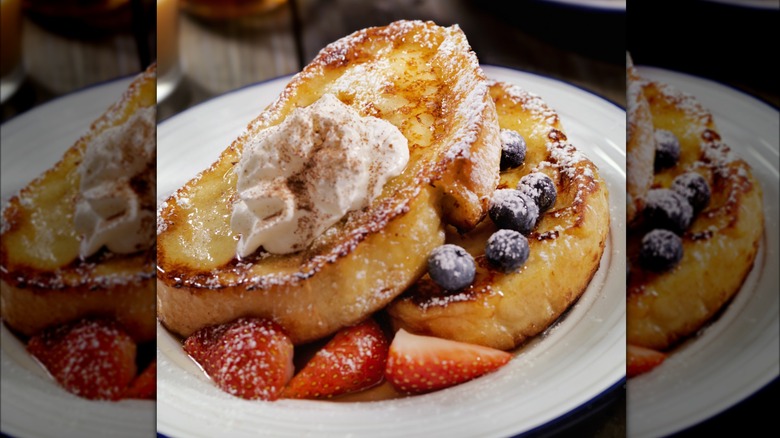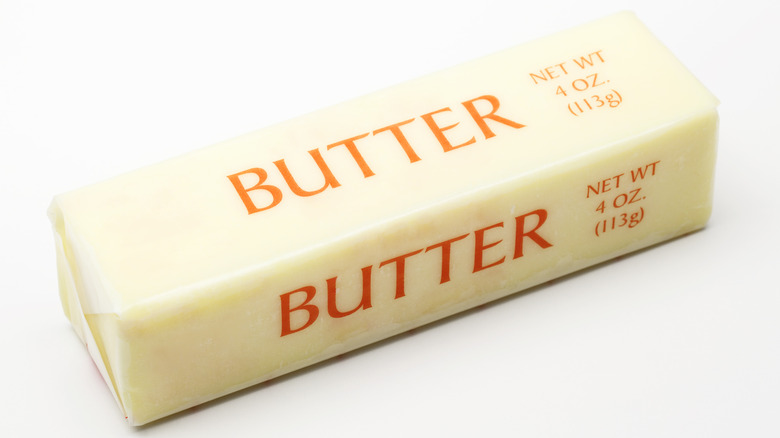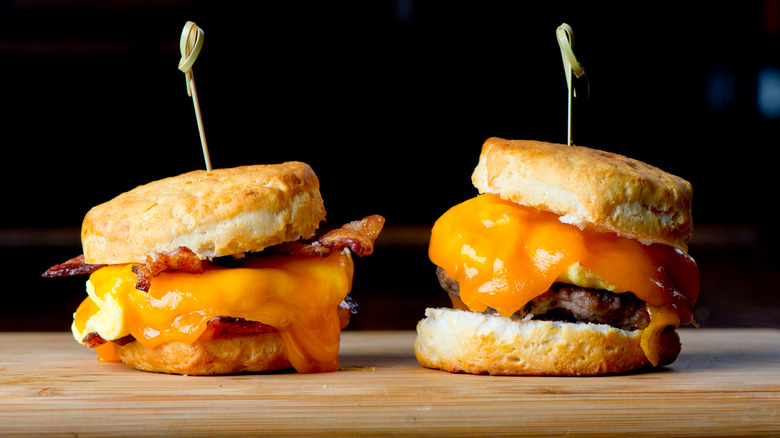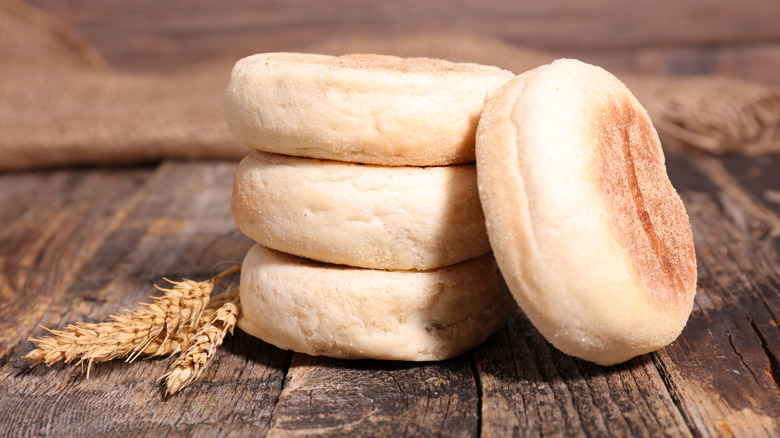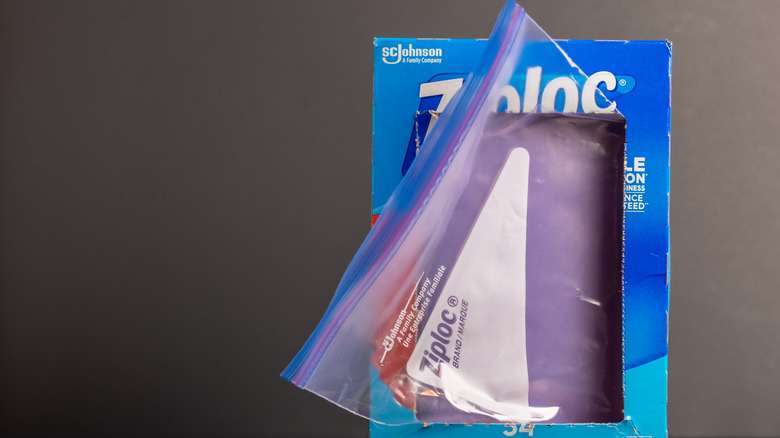10 Mistakes You Might Be Making With English Muffins
Crunchy yet fluffy, there's a lot to love about English muffins. The roots of this ever-popular baked good can be traced back to Samuel Bath Thomas, who emigrated to New York City from England. His recipe for griddle-cooked English muffins (at the time, what Thomas referred to as toaster crumpets) grew increasingly popular, prompting him to open up the now-famous bakery company that bears his name. These days, there's a lot more competition on the market, with countless bakeries offering their own special spin on this beloved baked good. According to Statista, over a 170 million American eat English muffins every year — and that number is only projected to keep climbing.
Despite English muffins being so popular, it's highly possible that these breakfast staples have some untapped potential that you may not be privy to or taking advantage of. Most of us have a tendency to stick with the same old routine when it comes to English muffins, not fully appreciating their delicious possibilities. In fact, some common English muffin preparation methods (or lack thereof) might even be considered missed opportunities. If you dig English muffins but you're open to suggestions on how to change it up, you're in the right place. Here are some mistakes that you might be making with English muffins.
1. Using plain butter
Don't get us wrong: We definitely love a creamy spread of butter on a toasted English muffin. It's the type of butter we're taking issue with here. While there's nothing necessarily wrong with using plain butter, the truth is that it can be a bit monotonous. Why not spice it up and make a few different tasty butter spreads for your English muffins? By making a quick compound butter (which is just a fancy word for softened butter that's been mixed and seasoned with other ingredients for more flavor complexity), you can vastly improve the flavor of your English muffins with minimal effort.
Try mixing room-temperature butter with a drizzle of some honey and a dash of fresh orange zest. Stir everything until it's well-combined and then spread it on a freshly-toasted English muffin. The sweetness of the honey mixed with creamy butter is delicious all on its own, but the refreshing notes of citrus from the orange zest take it to another level. If you want to take the butter a step further, add a sprinkle of cinnamon. Tasting the vibrant flavors of homemade compound butter will unlock a whole new world of possibilities for your tastebuds. If you find yourself exclusively using plain butter on your English muffins, you're missing out on some major deliciousness.
2. Not using them for pizza or garlic bread
When it comes to English muffins, one of the first things that comes to mind is breakfast. And while English muffins are a sensible choice for a bite to eat in the morning, the truth is that they're far more versatile. If you think about it, their circular shape, crispy edges, and fluffy interior make them perfect for another purpose: mini pizzas.
Toast some English muffins, add some tomato sauce, toppings, and cheese, then bake until the cheese is bubbly and lightly browned. The beauty of using English muffins for pizza is that you can easily customize a variety of personal mini pizzas with different toppings. Try making a meat-lover pizza with pepperoni and sausage, a veggie-lover pizza with mushrooms and olives, and a white pizza with garlic and ricotta. Just be sure to bake them long enough so that the bottoms of the English muffins get a little crispy so that there's some subtle crunch and tasty texture.
English muffins also make great garlic bread. Add some roasted fresh garlic, oregano, garlic powder, and a pinch of salt along with a dash of crushed red pepper flakes to some butter. Then spread the garlic butter onto cut English muffins and bake until they're golden brown. The texture of English muffins makes them ideal for easy garlic bread — and their size is a good portion, too. Serve with spaghetti and meatballs, creamy chicken alfredo, lasagna, or any of your other favorite Italian dishes.
3. Forgetting about dessert
Most of the time, the first instinct with English muffins is to make something savory like a hearty sandwich stuffed with eggs and breakfast sausage. But English muffins are often forgotten when it comes to making a quick and easy dessert, which is a shame. Using toasted English muffins for some simple strawberry shortcakes is a smart way to put them to use and satisfy your sweet tooth.
Strawberry shortcake is typically made with a lightly-sweetened biscuit-like cake. But using some English muffins can definitely get the job done if you don't happen to have any cakes or biscuits on hand, or don't feel like making them from scratch. We'd recommend opting for a thicker, fluffier English muffin in this context that can mimic a more biscuit-like consistency.
Mix sliced fresh strawberries in a bowl with a few tablespoons of sugar, a little squeeze of fresh lemon juice, and a tiny pinch of salt. Then set aside in the refrigerator for at least 30 minutes. This macerates the strawberries, which is just a fancy way of saying that it softens and sweetens them. This process also produces a delicious, juicy syrup that's perfect to drizzle around desserts like strawberry shortcakes. After toasting your English muffins, top them with macerated strawberries, then a dollop of whipped cream. Voilà — dessert is served, all thanks to the almighty English muffin.
4. Not bringing them camping
Campfires tend to be used for grilling sausages and cheeseburgers or making s'mores. But when it comes to having a campfire breakfast, English muffins are a godsend — especially when you don't have the convenience of an electric toaster. English muffins crisp up very nicely over open flames, and often toast up better than thin slices of sandwich bread (which is easy to burn over a campfire).
English muffins also pair well with a lot of other ingredients that are often packed for camping trips. Peanut butter, jelly, eggs, and tuna are all great ways to add some flavor. There's a good chance that you'll pack some sliced sandwich bread along with buns for your hot dogs and hamburgers, but if you aren't also bringing English muffins on your camping trips, then you're missing out. Once you bring a sleeve or two on a camping trip, you'll wonder how you ever camped without them.
5. Splitting them open with knife
All English muffins fall into two camps: pre-cut and uncut. Pre-cut English muffins are either fully-cut or mostly-cut, while uncut English muffins need to be split open. In most cases, regardless of which type of English muffin you're dealing with, a little finesse is required to break the muffin apart and divide it in half. The question is: what's the best method?
Of course, when just about anything needs to be cut, the first tool that comes to mind is a knife. But in the case of English muffins, a knife isn't exactly ideal. Because knives slice in a way that creates an even surface, cutting an English muffin with a knife can level out the nooks and crannies. Nooks and crannies are a bit part of what make English muffins so desirable, since they add little crags and small holes in the bread that add toasty texture.
If your English muffins are pre-cut, try prying them open with your hands instead. The tear is bound to be imperfect, but this is a good thing, as it will encourage more variation in texture. If the English muffins are totally uncut, use a fork to pop them open to achieve a similar result.
6. Not using them to make french toast
A lot of different breads can make good French toast: brioche, challah, or even just plain sliced sandwich bread. Even though their use is a bit unconventional in this context, English muffins can make great French toast, too. The exterior surface of English muffins is usually a bit more crunchy while the interior is softer and fluffier, which primes it to make some ideal French toast.
To make French toast with English muffins, simply follow the same steps that you would with any other type of bread. In fact, there's a hidden benefit to using English muffins: they're easy to make stuffed French toast. Because English muffins already have a soft interior riddled with little holes and crevices, it's easy to use a piping bag to infuse them with some delicious fillings, such as sweetened cream cheese or strawberry jam. After you've stuffed your English muffins with your desired filling, give them a dunk in egg batter mixed with milk and vanilla, then fry them up in a buttered skillet until they're golden brown. Top with a drizzle of maple syrup and dig in!
7. Using cold butter
We've all been there. The English muffin just popped out of the toaster. It's piping hot and ready for some butter — but the butter is still buried somewhere in the fridge. After fetching the butter and plopping down a little knob on the English muffin, it sits there in defiance, firm and resolute, resisting the urge to melt because it's still stone-cold. What makes this moment even more frustrating is how utterly preventable this common mistake is.
Our advice: always have a little room temperature butter on hand — just make sure it's safely stored. When your English muffins jump out of the toaster, you want to lay down some creamy, room-temperature butter so that it can spread across the entire surface with ease. The butter will melt faster, which means you can start chowing down sooner and enjoy the English muffin as it's truly meant to be eaten — while it's still warm. If you find yourself using cold butter on your English muffins, it's never too late to reverse course. This is an easy fix that's totally worth it, especially since room-temperature butter has so many uses in other applications.
8. Not making sandwiches with them
If you're pressed for time, it might be tempting to eat English muffins with a spread of jam or butter for breakfast and call it a day. But English muffins are also a great option to make some little sandwiches for lunch. When you don't have any rolls or hoagies on hand, try putting your English muffins to good use.
Tuna melts extra delicious on English muffins. The important thing to remember here is to toast the English muffin before you spoon on the tuna salad. The crunchy surface of the English muffin will provide some textural contrast to the delicate tuna, while also preventing it from becoming soggy. After the English muffin has been toasted and topped with tuna, add a slice of cheese and then bake until it's gooey and melted. Of course, English muffins will work for just about any other sandwich, too. BLTs, mini club sandwiches, burgers — English muffins can serve as the buns for all kinds of handheld delights. Give it a whirl and see what you've been missing out on.
9. Failing to meal-prep breakfast sandwiches
Most mornings, many of us are pressed for time and rushing to get out the door. This can make having a solid breakfast challenging, especially since we're commonly informed that it's also the most important meal of the day. The good news is that English muffins are a great solution to this problem. But rather than taking the time to make a breakfast sandwich from scratch every day, why not just prepare sandwiches for the week ahead of time?
Toast a bunch of English muffins in the oven, then stack on some scrambled eggs, ham, and cheese. Wrap the sandwiches in aluminum foil, then place all of the sandwiches in a plastic storage bag for the freezer. The night before you have breakfast, take a tin-foiled wrapped sandwich out of the freezer and place it in the refrigerator to defrost overnight. By morning, it should be ready for the toaster oven. Taking a little time to meal-prep some breakfast sandwiches with English muffins is totally worth it.
10. Storing them the wrong way
English muffin brands come in various packages. Some come in a plastic bag that claims to be resealable, but the reality is that English muffins can still get stale in there pretty easily. An easy way to fix this is to put your English muffin bags in a sealed storage container for some extra protection.
Another common mistake is storing English muffins in a spot that's subjected to warmth and sunlight — possibly too close to a window in the kitchen. This warmth can generate humidity inside the English muffin bag, which makes the bread sticky. Worse yet, this moisture may cause some rapid mold growth on the English muffins. For this reason, it's best to store your English muffins in a dry, cool space. After you've sealed them in a container to prevent them from going stale, try keeping them in a pantry or a bread box to keep them as fresh as possible.
